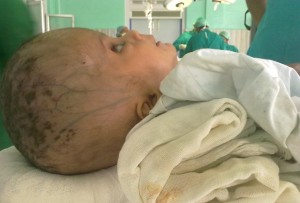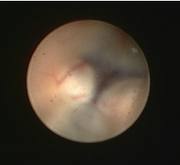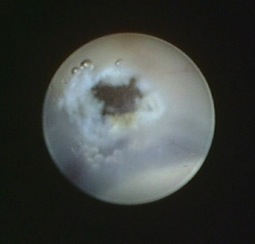CASE REPORT
Perioperative management for endoscopic third ventriculostomy
Safiya I. Shaikh, MD*, Bhagya D.V, MBBS**
*Professor & Head; **Post-graduate Student.
Department of Anaesthesiology
Karnataka Institute of Medical Sciences, Hubli , Karnataka (India)
Correspondence: Dr. Safiya I. Shaikh, Professor AND Head, Department of Anaesthesiology, Karnataka Institute of Medical Sciences, Hubli–580 022, Karnataka (India); Phone: 0836-2740937; Cell: 09448861706; E-mail I.D.: ssafiya1l@yahoo.com
ABSTRACT :
Endoscopic third ventriculostomy (ETV ) has been accepted as the method of choice in the treatment of obstructive hydrocephalus. The procedure requires general anesthesia and involves manipulation of brain neural structures to access the floor of third ventricle. We here report a case discussion of perioperative anesthetic management of a five month old infant with obstructive hydrocephalus posted for endoscopic third ventriculostomy.
Key words: ETV; Endoscopic third ventriculostomy; Intracranial pressure
CITATION: Shaikh SI, Bhagya DV. Perioperative management for endoscopic third ventriculostomy – a case report. Anaesth Pain & Intensive Care 2012;16(1):77-80.
INTRODUCTION
ETV has become the standard surgical procedure for treatment of non-communicating hydrocephalus.1 It is a quick, simple, minimally invasive procedure with less morbidity and mortality compared to standard ventriculo-peritoneal shunt placement.2,3 Perioperative management of ETV poses a great challenge to the anesthesiologist specially with regard to an associated raised intracranial pressure and the younger age group. We present a case of a young child, who was successfully managed through this procedure at our hospital.
CASE REPORT
A 5-month old female baby presented with obstructive hydrocephalus, secondary to improperly treated sepsis/meningitis. She had a history of being born preterm and had a birth weight of 1.99 kg. She had been admitted to the hospital in the first month of her life for sepsis and septic shock in NICU for 15 days. Presently, she was brought with the complaints of continuous increase in her head size for four months. On examination, she was alert, conscious and active, her head circumference was 52 cm, had a bulging anterior fontanellae and sun set sign was positive. Her heart rate was 126 beats/min and respiratory rate 28 breaths/min. Investigations revealed Hb 10.3gm%.
She was scheduled for endoscopic third ventriculostomy. After a thorough pre-anesthetic examination and preparation, she was accepted for the surgery.
In the operating room, her pre-operative vital signs were; HR-125 beats/min and SpO2-99% at room air. A difficult intubation was anticipated due to a large head size, so a meticulous preoperative preparation was done for difficult airway management, including different types of laryngoscope blades and LMA. She was premedicated with inj. glycopyrolate 0.04mg, inj. midazolam 0.1mg and inj. fentanyl 8µg IV. Preoxygenation was done for 5 min and anesthesia was induced with inj. thiopentone 25mg IV. An assistant pushed his hand beneath the upper chest of the baby to raise it slightly and the head was fixed in position by means of small rolled towels on each side. After confirming mask ventilation, oral intubation was done with a 4.0 mm noncuffed endrotracheal tube with inj. succinyl choline 4mg IV. Bilateral air entry was confirmed and tube secured. Inj. atracurium 2mg bolus was given for muscle relaxation and repeated for maintenance at regular intervals. Anesthesia was maintained intraoperatively with isoflurane in 50% O2 and N2O. Ventilation was done with an inspiratory pressure set at 12cmH2O and a respiratory rate of 30 breaths/min. She remained stable throughout the procedure with HR fluctuations between 120-130 beats/min. The course of anesthesia remained uneventful. At the end of the procedure, baby was reversed with inj. neostigmine 0.2mg IV plus inj. atropine 0.08mg IV and was extubated. She became fully conscious with good respiratory efforts postoperatively, with HR-134 beats/min and SpO2– 100% . She was kept in NICU for observation for 24hrs, remained haemodynamically stable and was shifted to the ward after 24 hrs to be discharged after 15 days.
DISCUSSION
After the development of valve regulated shunts in 1950’s, many surgeries have been widely used to treat hydrocephalus. High failure rates and numerous complications have been reported with the introduction of neuroendoscopic procedures. Endoscopic third ventriculostomy has become the preferred treatment for obstructive hydrocephalus because it is minimally invasive and offers the surgeon with a brilliant visual control of the manoevure.4
In the anaesthetic management of our case, anticipating difficult intubation due to large head size we had done a preoperative preparation for difficult airway management. We arranged additional equipment for this purpose including facemasks, oropharyngeal airways, tracheal tubes, laryngeal mask airways of different sizes and laryngoscope blades of different types appropriate for our patient. Pediatric fiberoptic bronchoscope was not available at that time. Weight appropriate breathing circuit was checked for correct configuration and patency. Standard monitoring like pulse oximetry, electrocardiogram, non invasive blood pressure, capnography and nasal temperature measurement were instituted.
For proper alignment of oral, pharyngeal and laryngeal axis to facilitate intubation, we used an adequate size shoulder pad and small rolled towels on both sides for the patient. Additionally, an assistant was asked to raise the upper chest by his hand as and when needed. Sedative premedication should be considered carefully as it may mask the signs of neurological dysfunction. Conversely an anxious patient can have detrimental rise in ICP during induction.13 Hence, we used sedation very cautiously in appropriate doses and monitored carefully throughout the surgery.
Volume status and normothermia were also adequately managed intraoperatively in our case. Baby was stable throughout intraoperatively in our case. After the procedure, baby had adequate respiratory efforts with vitals stable hence reversal and extubation was considered without post operative ventilatory support. Baby was monitored in the NICU post operatively for 1 day for any complications. Since the baby was stable, she was shifted back to wards and later discharged.
Intraoperative haemodynamic changes during ETV have been extensively studied with conflicting results. Murshid reported Increased intracranial pressure could cause tachycardia and systemic hypertension due to high speed fluid irrigation / kinking of the outflow tube.5 Cushing response can occur due to compression of hypothalamus by dilated third ventricle. Bayken et al reported intraoperative bradycardia in 28.1% and the respective rates for asystole and bradycardia were 0.5% and 12.4% with overall incidence of arrhythmia as 41%. Increasing ICP indefinitely would lead to cardiac arrest. Leach et al reported in two occasions during ETV a profound bradycardia leading to short lived, spontaneously resolving episodes of asystole.
Intraoperatively during fenestration vascular injuries like rupture of basilar artery can occur leading to haemorrhage. Bayken et al reported 5 cases of mild venous bleeding which was controlled by irrigation. Early complications include transient ocular divergence, anisocoria and hyponatremia. Five children were diagnosed with temporary diabetes insipidius in late post operative period.9 High pressure levels inside the endoscope during the procedure can occur without haemodynamic warning signs. Any pressure > 30 mm Hg are associated with post operative morbidity especially unexpected delay in recovery and neurological deficits.10
Another issue of interest following ETV is post operative electrolyte imbalance like hyperkalemia probably due to hormonal dysfunction and use of lactated ringer solution for irrigation.4
Hence a well planned perioperative management of anaesthesia is required for a neurosurgical procedure like ETV. Such a management reduces the perioperative morbidity and mortality. Though the neuroendoscopic approach is considered safe for treating hydrocephalus in children, complications can be severe and lethal and the anaesthesiologist must respond accordingly.
CONCLUSION :
ETV is most effective in treating obstructive hydrocephalus. ETV is still effective in two-thirds of the patients with previous infections. With the increasing use of this technique nowdays, understanding the pathophysiological changes that occur could be important. We conclude that a well planned peri operative management by the anaesthesiologist can contribute to a better recovery and outcome for a novel technique like ETV. Also, application of sound basic principles will allow for the safe conduct of surgery in this varied and challenging population of children.
REFERENCES:
1. El-Dawlatly, Murshid WR, Elshimy. ‘The incidence of Bradycardia during endoscopic third ventriculostomy’. Anesth Analg 2000; 91:1142-4.
2. El-Dawlatly, Elgamal E, Murshid W, Alwatidy S, Jamjoom Z, Alshaer A. ‘Anesthesia for third ventriculostomy’. MEJ ANESTH 2008; 19(4).
3. Jones RTF, Stening WA, Byrdon M. ‘Endoscopic III ventriculostomy’. Neurosurgery 1990; 26:86-92.
4. Omidvar R, Guive S, Mohammad samadian, Haddadian K, Asgari A A, Yazdani M. ‘Endoscopic third ventriculostomy for treatment of hydrocephalus’. Archives of Iranian medicine 2007; 10(4):498-503.
5. Mushid WR. ‘Endoscopic Third ventriculostomy. Towards more indications for the treatment of non-communicating hydrocephalus’. Minim Invas Neurosurg 2000; 43:75-82.
6. Anandh B, Madhusudan reddy KR, Mohanty A, Umamaheshwara rao G S, Chandramouli B A. ‘Intraoperative bradycardia and post operative hyperkalemia in patients undergoing endoscopic third ventriculostomy’. Minim invas Neurosurg 2002; 45:154-7.
7. Fabregas N, Lopez A, Valero R, Carrero E, Caral L, Ferrer E. ‘Anesthetic management of surgical neuroendoscopies. Usefulness of monitoring the pressure inside the neuroendoscope’. J Neurosurg Anesthesiol 2000; 12:21-28.
8.Derbent A, Ershin Y, Yurtseven T. ‘Haemodynamic and electrolyte changes in patients undergoing neuroendoscopic procedures’. Childs nerv syst 2006; 22:253-257.
9. Baykan N, Isbir O, Gercek A, Dagcnar A, Ozek M M. ‘Ten years of experience with paediatric neuroendoscopic third ventriculostomy. Features and perioperative complications of 210 cases’. J Neurosurg Anesthesiol jan 2005; 17(1): 33-37.
10. Hopf, Nikolai J.M.D, Grunert P, Fries G, Resch Klaus D M, Perneczky A . ‘Endoscopic third ventriculostomy. Outcome analysis of 100 consecutive procedures’. Neurosurgery April 1999; 44(4): 795-804.
11. Hazem Mostafa kamal. ‘Endoscopic Procedures for management of ventriculo-peritoneal shunt malfunction and malposition’. Egypt J Neurol Psychiat Neurosurg jan 2010; 47(1):367-371.
12. Ambesh, Sushil P, Kumar raj. Neuroendoscopic procedures. ‘Anesthetic considerations for a growing trend’. J Neurosurg Anesthesiology july 2000; 12(3): 262-270.
13. R Sunderland, S Mallory. ‘Anesthesia for ventriculo-peritoneal shunt insertion’. Anesthesia tutorial of the week 121, 8th December 2008.
PICTURES:
Fig 1: Pre operative picture of the infant.
Fig 2: Positioning of the infant for intubation.
Fig 3: Endoscopic view of floor of third ventricle.
Fig 4 : Endoscopic view after the third ventriculostomy.





